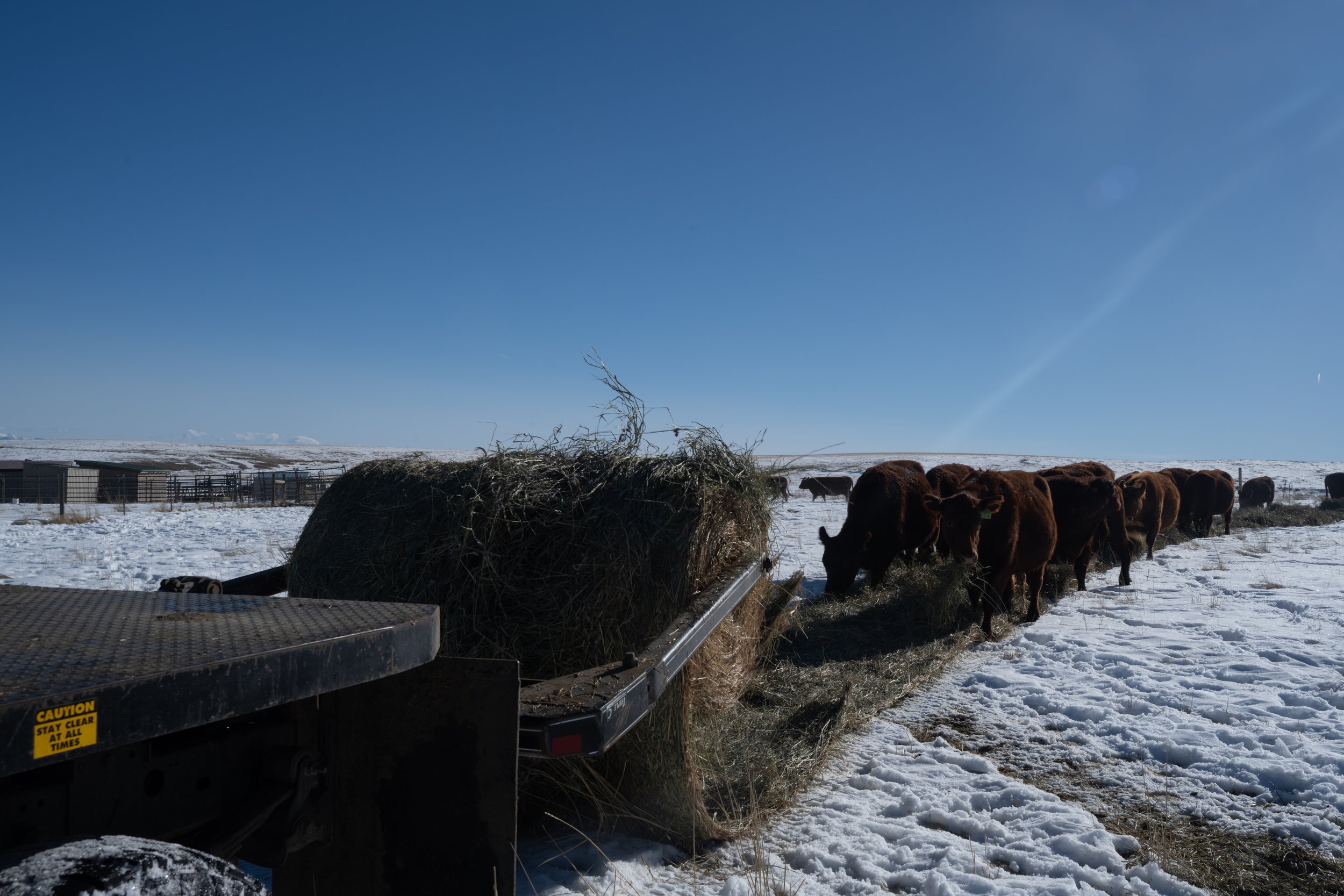
Jenny Kahrl: Red Devon Ranch
What I find is Jenny Kahrl, the owner, range boss, and manager of the Montana Red Devon Ranch. She invites me into a long kitchen surrounded by a wall of windows with a view of the spring–snow-covered Tobacco Root Mountains. A cat curls up on a cushion on the table, and a Staffordshire bull terrier named Caesar attempts to climb my legs.
After Jenny changes into her barn clothes, we load up into a flatbed truck that’s equipped with a HydraBed, a hydraulic bale feeder. We jolt our way up a beaten track to an upper pasture where a herd of 20 cows are gathered. Jenny tells me that the bulls all stay lower down the hill in their own pen, and that the cows must always remain separated to keep the bulls from attempting to impregnate them.
The cows do not like me—they eye me as I edge around the truck and balance between piles of manure. Jenny keeps herself between them and me so that I don’t get kicked. When I pet one, it’s softer than I expected, but still coarse. I avoid the mess on her backside.
Kahrl started ranching over 25 years ago, when the discussion around ranching focused more on the carbon footprint of each cow and less on the interconnected aspects of water rights and agriculture as a whole.
Kahrl’s ranch has one of the oldest water rights in Harrison, MT. That means that in times of drought, her land is among the last to go dry. Still, a drought in 2021 impacted her, and the ranch went from 80 head of cattle to 30. Montana ranchers lost nearly 300,000 cattle that year, dropping to about 2.2 million by 2022, according to the U.S. Department of Agriculture.
As Kahrl explains it, drought didn’t necessarily limit how much the cattle could drink as much as it dramatically reduced the production of hay and grass in her pastures, which means that ranchers had to buy hay to keep their herds alive, though hay was scarce all around. As a result, ranchers like Kahrl ended up selling their cattle en masse so that they could afford to keep their operations running.
After we drive the rest of the hay down to the bulls by the barn, Kahrl stops the truck and then whips us back around to her house. She phones her neighbor, Wayne Wilson, who shares some land with her. One of Wilson’s cows is in labor in the lower pasture, and Kahrl is checking to see if he needs her help.
“The ranchers in the valley look out for one another,” she tells me. “The only thing we have out here on the wide-open spaces is each other.”
Wilson comes by to check on the laboring cow, and Kahrl cracks the door to the barn. Inside the barn and nursery another cow and her day-old calf are staring at us from the shadows. The calf attempts to totter toward us. It’s small and gangly, though steady on its feet. The mother shoves herself between the calf and us. Mother cows are protective of their calves, to the point that they do not want any strange humans near their offspring.
Wayne ushers the laboring cow into an empty pen. She is almost ready to drop her calf, and she pauses every so often as another contraction hits her. When she turns away from us, Kahrl points out the pink of the amniotic sac protruding out of her vaginal canal. I can see sunshine through the sac, not unlike the bubble you get from pink bubble gum.
We talk for over 90 minutes, and all the while the cow continues to pace and goes through contraction after contraction. She’s calm, but every so often, she lets out a few low moos.
“She’s a noisy one,” says Kahrl.
At one point, for just a second, we turn away. When we glance back, the cow has finished her task without so much as a cry. She is licking her baby—a small black calf glistening in the early spring sunshine.
Jenny Kahrl: Red Devon Ranch
Story by Ariana Crockett O’Harra
Photos by Ariana Crockett O’Harra
I am not a rancher. I have never loaded hay, never trekked through cow manure, and never even met a cow. I’m not sure what to expect when I pull up to a small house set in the foothills of the Tobacco Root Mountains, surrounded by late winter hay fields, farm outbuildings, and cow pastures.

